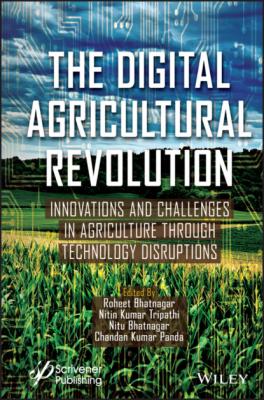The Digital Agricultural Revolution. Группа авторов
Чтение книги онлайн.
Читать онлайн книгу The Digital Agricultural Revolution - Группа авторов страница 23
 in Meta data file
in Meta data file
(2.5)
where BT = Top of atmosphere brightness temperature (°C), Lλ = Top of atmospherespectral radiance (Watts/(m2 * sr * μm)), K1 = K1 Band Constant, K2 = K2 Band Constant.
Crop Water Stress Index (NDVI/Ts) is taken as one of the indicators of crop yield. The water stress index (WSI or CWSI) quantifies moisture stress and relationship between plant temperature and stress [68]. Crop Water Stress Index was used for moisture deficit monitoring with best results and revealed that there was a close relationship in between WSI and crop water content [69].
The crop yield data (crop cutting data) are collected for 5 years. Five years of data are sufficient for estimates of yield potential for fully irrigated production systems [70] and is adopted for the present study. The crop yield per unit area of different crops for the years 2013 to 2017 is collected from Directorate of Economics and Statistics, Vijayawada. The location details of the data collected is in the form of survey numbers of revenue department. To know latitude and longitude and also to collect previous years’ data at each crop cutting point ground truth is done by using EpiCollect (A mobile based App) (Figure 2.3).
Figure 2.3 Illustration of collection of ground sample points using EpiCollect app (original figure).
2.5.3 Results and Conclusions
The parameters selected as input variables for neural network were derived for each season separately for all years. The APAR derived from Landsat 8 image on 14 October 2015 is shown in Figure 2.4. The spatial distribution of APAR values varied from 0.4369 to 0.7741. The higher APAR was observed at cropped area and was the lowest at water bodies. Similarly, the crop water stress index was derived and was presented in Figure 2.4 (a). The CWSI on the day of derived is shown in Figure 2.4 (b), which is a proxy for water stress. The CWSI varied from 0-1. The CWSI matched with irrigation canals. The CWSI is high in the areas where there is a low supply of irrigation water, especially in the lower parts of the area. Mandal wise-extracted mean crop yield parameters are presented in Table 2.2.
The selected yield parameter maps were derived from satellite images and were given as input to FFBP NN model. Time series NDVI, Ts, CSWI, and APAR maps were retrieved from remotely sensed images from transplanting to the harvesting stage of paddy crop. The values for the ground truth points of all parameters derived by remote sensing were extracted. Spatial distribution of sample points is shown in Figure 2.5. The attributes of abovementioned derived thematic maps are extracted for all the sample points and exported to Excel as .csv file (Figure 2.6) for preparation of input files to neural network structure.
Figure 2.4 (a, b). APAR and CSWI maps of KCD on October 14, 2015 (original figure).
Figure 2.5 Synoptic view of spatial distribution of sample points of crop collected (original figure).
Table 2.2 Sample normalized input data of FFBPNN yield estimation model of paddy crop in kharif during 2015.
| S. no. | Mandal name | NDVI | Ts | APAR | Water index | Normalized average yield |
|---|---|---|---|---|---|---|
| 1 | Vijayawada rural | 0.542 | 0.831 | 0.775 | 0.354 | 0.674 |
| 2 | Kankipadu | 0.548 | 0.148 | 0.778 | 0.448 | 0.855 |
| 3 | Challapalle | 0.539 | 0.792 | 0.773 | 0.180 | 0.544 |
| 4 | Pamarru | 0.528 | 0.577 | 0.768 | 0.224 | 0.533 |
| 5 | Vuyyuru | 0.531 | 0.330 | 0.770 | 0.325 | 0.744 |
| 6 | Movva | 0.687 | 0.363 | 0.844 | 0.723 | 0.725 |
| 7 | Thotlavalluru | 0.687 | 0.439 | 0.844 | 0.686 | 0.450 |
| 8 | Avanigada | 0.563 | 0.454 | 0.785 | 0.359 | 0.000 |
| 9 | Pamidimukkala | 0.575 | 0.687 | 0.791 | 0.302 | 0.900 |